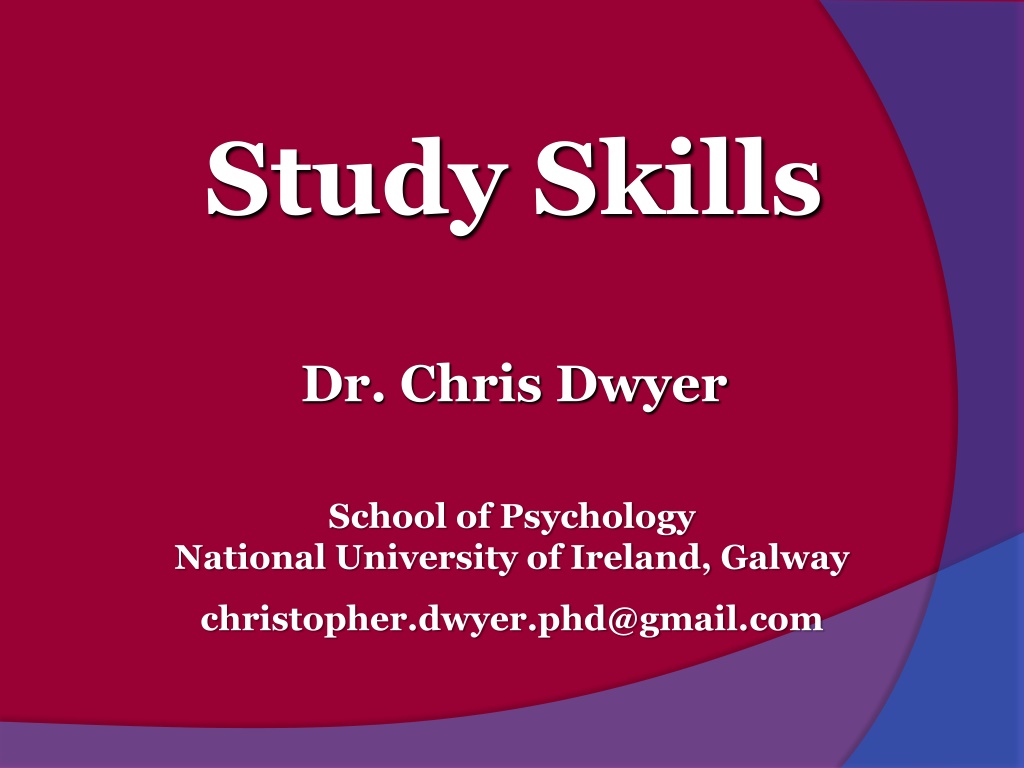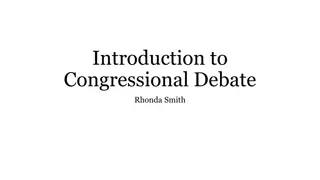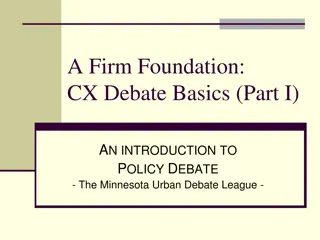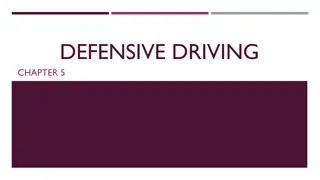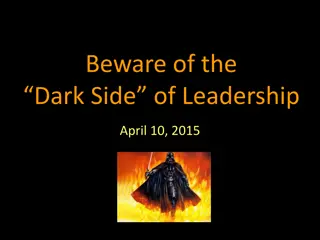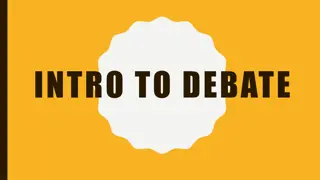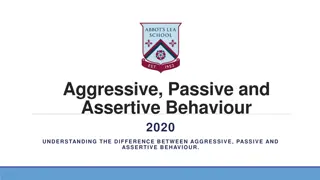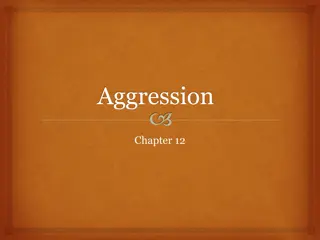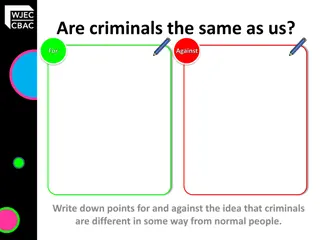Understanding the Nature vs. Nurture Debate in Aggressive Behavior
Aggression is a prevalent issue in society, with factors like biology (testosterone levels, genetics) and environment (parental influence, exposure to violence) playing crucial roles. The debate on whether aggression stems from nature or nurture is explored through various perspectives, such as ethology, Freudian theories, and the frustration-aggression theory. While biological factors like testosterone can influence aggression, environmental influences like parental behavior and exposure to violence also play significant roles in shaping aggressive behavior.
Download Presentation

Please find below an Image/Link to download the presentation.
The content on the website is provided AS IS for your information and personal use only. It may not be sold, licensed, or shared on other websites without obtaining consent from the author. Download presentation by click this link. If you encounter any issues during the download, it is possible that the publisher has removed the file from their server.
E N D
Presentation Transcript
Study Skills Dr. Chris Dwyer School of Psychology National University of Ireland, Galway christopher.dwyer.phd@gmail.com
Aggression is a serious problem in society. It is commonplace to hear of events involving violence, verbal abuse and other forms of aggression. Many factors influence aggressive behaviour. For years, psychologists have sought to understand whether an individual s behaviour emerges as a result of nature (i.e. their biology) or nurture (i.e. their environment). Aggressive behaviour falls into this argument. Is aggressive behaviour a by product of nature or nurture? Ethologists have shown that aggression in members of a species can aid survival of that species. They have shown, for example, that intra-specific aggression has several biological advantages. When accompanied by rivalry among males for mating opportunities, intraspecific aggression tends to perpetuate the genes of the healthier, more vigorous animals. Freud theorised that thanatos (the death instinct) and libido (the sexual drive) help to form personality by virtue of the way sexuality and aggression were channelled. However, Freud s ideas are merely theoretical and little scientific findings support these ideas. This is because psychoanalytic ideas (e.g. the death instinct) cannot be adequately tested or falsified in an empirical fashion. One piece of evidence to suggest that biology causes aggression is the fact that testosterone is correlated with aggression. For example, there is evidence that high levels of testosterone are correlated with aggression, as are depleted levels of serotonin. Men have higher levels of testosterone and are generally more aggressive than women (Knight et al., 1996). The role testosterone plays in aggression was exemplified when Dabbs et al. (1988) found that female prison inmates who displayed unprovoked violence and who had received several other convictions also showed high levels of testosterone. Genetic factors play a major role in aggression (e.g. in the breed of dogs). Inbreeding can create unstable temperaments, and hormones can contribute to aggressive tendencies in intact male dogs. However, an individual s environment can affect his or her testosterone level. For example, increases in testosterone have been found in Brazilian supporters who saw their team win the 1994 World Cup on television (Fielden et al., 1994). On the nurture side of things, various environmental factors may also influence aggression. For example, when parents habitually resort to aggression, their children are likely to do the same. In extreme cases of child abuse, parents who beat their children usually turn out to have been victims of child abuse themselves (Parke & Collmer, 1975). This can also be seen in work done by Bandura (1977) found that, after watching an adult interact with a Bobo Doll , children tended to imitate the observed behaviour. For example, if the adult beat the doll with a stick, children often did the same. Longitudinal studies tracing development from childhood to adolescence have found that long- term viewing of violence on television is associated with an increase in boys violent behaviour as adults (Lefkowitz et al., 1977). However, Feshbach & Singer (1971) found that being subjected to consistent violent television programmes, over six months, as a teenager, didn t increase levels of aggression and found that in some cases individuals were less aggressive. Displacement of responsibility is an important factor in aggressive behaviour. When people feel less responsibility for their behaviour (e.g., in mob situations), they are more likely to act aggressively. Aggression tends to increase in groups, which is a result of group polarization. Group attitudes often polarize (i.e., become more extreme) when individuals with similar attitudes get together. One outcome is extreme aggression. Dollard et al. (1939) proposed that aggressive behaviour results from frustration in attempts to achieve personal goals. Dollard said that aggression is always a consequence of frustration and frustration always leads to some form of aggression . However, experimental evidence for the frustration-aggression theory is mixed. According to Berkowitz (1962), frustration yields anger and anger only leads to aggression when a person is exposed to an aggressive cue, e.g. a gun. In conclusion, one acknowledges that aggression is a serious problem in society. It is commonplace to hear of events involving violence, verbal abuse and other forms of aggression. There are many influences on aggressive behaviour, such as various biological and environmental factors. For years, psychologists have argued about whether or not human behaviour is the result of nature or nurture. Aggressive behaviour falls into this argument. There is no 'clear-cut' answer here, as both environmental and biological factors influence aggression.
WHAT IS AN ARGUMENT MAP? An argument map is a visual representation of that logically structured network of reasoning, in which the argument is made unambiguous and explicit. That is, there is no need for attention switching from paragraph to paragraph or from page to page in search of reasons and objections to the central claim around which the argument map is constructed.
Argument maps use a box and arrow design in which the boxes represent propositions (i.e. the central claim, reasons, objections and rebuttals) and the arrows among propositions indicate the inferential relationships linking the propositions together. Thus, the provision of an arrow between two propositions indicates that one is evidence for or against another.
Why would Argument Maps be able to facilitate improved learning? Maps are organised in a hiearchical structure, where propositions are identified as either reasons or objections. Colour (a Gestalt Grouping Principle of Similarity) allows the reader to easily differentiate reasons from objections. Argument Mapping removes the cognitive load (Sweller & Chandler, 1991) from thinking as the maps naturally chunk (Miller,1956) the propositions together in a close proximity, as opposed to text. Research suggests that argument maps not only improve memory (Dwyer, Hogan & Stewart, 2010; Dwyer, 2011), they also improve critical thinking (Alvarez-Ortiz, 2007; Butchart et al., 2009; Dwyer, 2011; van Gelder, 2000; 2001).
Aggression is a serious problem in society. It is commonplace to hear of events involving violence, verbal abuse and other forms of aggression. Many factors influence aggressive behaviour. For years, psychologists have sought to understand whether an individual s behaviour emerges as a result of nature (i.e. their biology) or nurture (i.e. their environment). Aggressive behaviour falls into this argument. Is aggressive behaviour a by product of nature or nurture? Ethologists have shown that aggression in members of a species can aid survival of that species. They have shown, for example, that intra-specific aggression has several biological advantages. When accompanied by rivalry among males for mating opportunities, intraspecific aggression tends to perpetuate the genes of the healthier, more vigorous animals. Freud theorised that thanatos (the death instinct) and libido (the sexual drive) help to form personality by virtue of the way sexuality and aggression were channelled. However, Freud s ideas are merely theoretical and little scientific findings support these ideas. This is because psychoanalytic ideas (e.g. the death instinct) cannot be adequately tested or falsified in an empirical fashion. One piece of evidence to suggest that biology causes aggression is the fact that testosterone is correlated with aggression. For example, there is evidence that high levels of testosterone are correlated with aggression, as are depleted levels of serotonin. Men have higher levels of testosterone and are generally more aggressive than women (Knight et al., 1996). The role testosterone plays in aggression was exemplified when Dabbs et al. (1988) found that female prison inmates who displayed unprovoked violence and who had received several other convictions also showed high levels of testosterone. Genetic factors play a major role in aggression (e.g. in the breed of dogs). Inbreeding can create unstable temperaments, and hormones can contribute to aggressive tendencies in intact male dogs. However, an individual s environment can affect his or her testosterone level. For example, increases in testosterone have been found in Brazilian supporters who saw their team win the 1994 World Cup on television (Fielden et al., 1994). On the nurture side of things, various environmental factors may also influence aggression. For example, when parents habitually resort to aggression, their children are likely to do the same. In extreme cases of child abuse, parents who beat their children usually turn out to have been victims of child abuse themselves (Parke & Collmer, 1975). This can also be seen in work done by Bandura (1977) found that, after watching an adult interact with a Bobo Doll , children tended to imitate the observed behaviour. For example, if the adult beat the doll with a stick, children often did the same. Longitudinal studies tracing development from childhood to adolescence have found that long- term viewing of violence on television is associated with an increase in boys violent behaviour as adults (Lefkowitz et al., 1977). However, Feshbach & Singer (1971) found that being subjected to consistent violent television programmes, over six months, as a teenager, didn t increase levels of aggression and found that in some cases individuals were less aggressive. Displacement of responsibility is an important factor in aggressive behaviour. When people feel less responsibility for their behaviour (e.g., in mob situations), they are more likely to act aggressively. Aggression tends to increase in groups, which is a result of group polarization. Group attitudes often polarize (i.e., become more extreme) when individuals with similar attitudes get together. One outcome is extreme aggression. Dollard et al. (1939) proposed that aggressive behaviour results from frustration in attempts to achieve personal goals. Dollard said that aggression is always a consequence of frustration and frustration always leads to some form of aggression . However, experimental evidence for the frustration-aggression theory is mixed. According to Berkowitz (1962), frustration yields anger and anger only leads to aggression when a person is exposed to an aggressive cue, e.g. a gun. In conclusion, one acknowledges that aggression is a serious problem in society. It is commonplace to hear of events involving violence, verbal abuse and other forms of aggression. There are many influences on aggressive behaviour, such as various biological and environmental factors. For years, psychologists have argued about whether or not human behaviour is the result of nature or nurture. Aggressive behaviour falls into this argument. There is no 'clear-cut' answer here, as both environmental and biological factors influence aggression.
Aggression is a serious problem in society. It is commonplace to hear of events involving violence, verbal abuse and other forms of aggression. Many factors influence aggressive behaviour. For years, psychologists have sought to understand whether an individual s behaviour emerges as a result of nature (i.e. their biology) or nurture (i.e. their environment). Aggressive behaviour falls into this argument. Is aggressive behaviour a by product of nature or nurture? Ethologists have shown that aggression in members of a species can aid survival of that species. They have shown, for example, that intra-specific aggression has several biological advantages. When accompanied by rivalry among males for mating opportunities, intraspecific aggression tends to perpetuate the genes of the healthier, more vigorous animals. Freud theorised that thanatos (the death instinct) and libido (the sexual drive) help to form personality by virtue of the way sexuality and aggression were channelled. However, Freud s ideas are merely theoretical and little scientific findings support these ideas. This is because psychoanalytic ideas (e.g. the death instinct) cannot be adequately tested or falsified in an empirical fashion. One piece of evidence to suggest that biology causes aggression is the fact that testosterone is correlated with aggression. For example, there is evidence that high levels of testosterone are correlated with aggression, as are depleted levels of serotonin. Men have higher levels of testosterone and are generally more aggressive than women (Knight et al., 1996). The role testosterone plays in aggression was exemplified when Dabbs et al. (1988) found that female prison inmates who displayed unprovoked violence and who had received several other convictions also showed high levels of testosterone. Genetic factors play a major role in aggression (e.g. in the breed of dogs). Inbreeding can create unstable temperaments, and hormones can contribute to aggressive tendencies in intact male dogs. However, an individual s environment can affect his or her testosterone level. For example, increases in testosterone have been found in Brazilian supporters who saw their team win the 1994 World Cup on television (Fielden et al., 1994). On the nurture side of things, various environmental factors may also influence aggression. For example, when parents habitually resort to aggression, their children are likely to do the same. In extreme cases of child abuse, parents who beat their children usually turn out to have been victims of child abuse themselves (Parke & Collmer, 1975). This can also be seen in work done by Bandura (1977) found that, after watching an adult interact with a Bobo Doll , children tended to imitate the observed behaviour. For example, if the adult beat the doll with a stick, children often did the same. Longitudinal studies tracing development from childhood to adolescence have found that long- term viewing of violence on television is associated with an increase in boys violent behaviour as adults (Lefkowitz et al., 1977). However, Feshbach & Singer (1971) found that being subjected to consistent violent television programmes, over six months, as a teenager, didn t increase levels of aggression and found that in some cases individuals were less aggressive. Displacement of responsibility is an important factor in aggressive behaviour. When people feel less responsibility for their behaviour (e.g., in mob situations), they are more likely to act aggressively. Aggression tends to increase in groups, which is a result of group polarization. Group attitudes often polarize (i.e., become more extreme) when individuals with similar attitudes get together. One outcome is extreme aggression. Dollard et al. (1939) proposed that aggressive behaviour results from frustration in attempts to achieve personal goals. Dollard said that aggression is always a consequence of frustration and frustration always leads to some form of aggression . However, experimental evidence for the frustration-aggression theory is mixed. According to Berkowitz (1962), frustration yields anger and anger only leads to aggression when a person is exposed to an aggressive cue, e.g. a gun. In conclusion, one acknowledges that aggression is a serious problem in society. It is commonplace to hear of events involving violence, verbal abuse and other forms of aggression. There are many influences on aggressive behaviour, such as various biological and environmental factors. For years, psychologists have argued about whether or not human behaviour is the result of nature or nurture. Aggressive behaviour falls into this argument. There is no 'clear-cut' answer here, as both environmental and biological factors influence aggression.
1. Nature or nurture 2. Biological advantages 3. Testosterone 4. Bobo Doll 5. Violent television programmes 6. Displacement of responsibility 7. Frustration-aggression theory
Memory Capacity: How Much Information? 7 2 items of information (Miller, 1956) For example, words and numbers Chunking (De Groot, 1946; 1978; Miller, 1956) refers to the cognitive act of combining a number of items into a single chunk or chunks
Lets try a little experiment based on research conducted by Severin & Rigby (1963).
Whats your number?
Magical Number 7 2 (Miller, 1956) 4681753 468 - 17 - 53 46 - 81 - 753 46 - 817 - 53
Make it Meaningful! e (Growth) and Andrew Jackson e = 2.718281828459045 e = 2.718281828459045
1. Nature or nurture 2. Biological advantages 3. Testosterone 4. Bobo Doll 5. Violent television programmes 6. Displacement of responsibility 7. Frustration-aggression theory
Nature or Nurture Bobo Doll Biological advantages Violent television programmes Testosterone Displacement of responsibility Frustration-aggression theory
Mnemonics Techniques used to assist memory, such as using pictures, rhymes or figures of speech. For example, Word Mnemonics
Word Mnemonics The categories in the classification of life are: Kingdom, Phylum, Class, Order, Family, Genus, Species, Variety Kingdom, Phylum, Class, Order, Family, Genus, Species, Variety = Kings Play Cards On Fairly Good Soft Velvet.
Acronyms The use of acronyms is a very common mnemoncic technique. An acronym is a word formed from the initial letters of a name or by combining initial letters of a series of words. For example, NATO = North Atlantic Treaty Organization
Whats on the Exam? Look at past Exams Is this the first time your lecturer has provided this module? What s the format of the exam? Multiple-Choice Questions Fill-in-the-blanks Essay Be sure to go to your (review) lectures for hints! If you don t get hints, consider what questions YOU would set if you had taught the course.
Revision Develop a clear overview of what needs to be covered in each subject. Draw up a revision plan. You might need to allocate more time to some subjects. Revise actively Just reading through your notes is not enough. Test yourself by working through problems, summarising key points, memorising and trying to replicate exam conditions.
Reading the Directions When the exam starts, write everything you fear you might forget onto the question sheet! Read the directions carefully: what to answer, where to answer, marking schemes, etc. Allocate a few minutes to scan the entire exam and select your preferred questions.
Answer Strategies: General Essays: Do the one(s) you think you might potentially forget the answers to first. N.B. Watch your handwriting: although you cannot be marked down for poor handwriting, it is difficult for lecturers to reward an illegible scrawl! Practice writing at speed. MCQs and Fill-in-the-blanks: Do the easiest ones first and quickly, coming back to the trickier ones afterwards with time to spare.
Answer Strategies: Short Answer Questions Short answer questions are usually designed to test your factual knowledge of a particular area. Lecture Slides, notes, highlighted words and phrases Read the text-book!
Answer Strategies: Fill-in-the-blanks It s generally acceptable to use key points and short sentences in these kind of questions. For maths questions, don t just give your answer show how you got there. FITB questions rarely carry negative marking, so it s best to make an educated guess if you don t know the answer.
Answer Strategies: MCQS MCQs are used to motivate students to cover the entire content of a course of study. MCQs usually consist of question or a phrase followed normally by four or five answer options. If your exam will contain MCQs, it s well worth getting plenty of practice in beforehand use past papers or practice questions and again, READ THE TEXT-BOOK!
Answer Strategies: MCQS It s a good idea to try to figure out the correct answer before looking at the answer options. If you can t do this, eliminate clearly incorrect options; thinking in terms of true or false can help here. You can generally eliminate 50-60% right away.
Answer Strategies: MCQS Don t select an option too soon. Be aware that there can be more than one correct option, but only one correct answer. If two options are correct, the correct answer might be answers (b) and (c) above , but be aware that it could also be all of the above . Be careful not to misread the question. Some people find negative or double negative questions confusing it may help to rephrase when this is the case.
Answer Strategies: MCQS Sometimes, having done the easiest questions first, you can revisit other questions, having picked up hints from those you have already answered. Tick off the questions you have answered with confidence. To guess or not to guess? Guessing with negative marking?
Review your work! If you have time at the end of any exam, resist the urge to leave the exam hall. Use the time to review what you have done thoroughly. Check for errors, make sure that you have answered all questions, and add any missing information. If you run out of time, jot down the key points that you would have made and the key terms that are relevant to the topic much like our outline from earlier.
